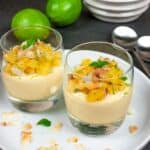
Piña Colada Panna Cotta with Pineapple and Lime
This velvety, coconut panna cotta is simple, delicious and impressive! It's a healthy, low-carb twist on Italian panna cotta, made with the most delicious piña colada flavored electrolytes. You'll love this silky, festive no-bake dessert!
Servings: 4 servings
Calories: 77kcal
Ingredients
- 2 cups full fat coconut milk
- 2 tablespoons powdered stevia or use sweetener of choice
- 1 teaspoon Ultima Replenisher Coconut Piña Colada electrolyte powder or 1 stickpack
- 2 teaspoons gelatin see post for vegan gelatin substitutes
- ¼ cup cold water
- ½ cup pineapple cut into ½ inch cubes
- 1 tablespoon lime juice
- 1 tablespoon rum optional
- 2 teaspoons mint leaves finely sliced
- 1 lime zest only
- ¼ cup dried flaked coconut or shredded coconut
Instructions
To prepare the pudding mixture:
- In a small saucepan, heat the coconut milk over medium heat and whisk in 1 tablespoon sweetener until dissolved.
- Add the cold water to a small, shallow bowl and sprinkle the gelatin over the top. Whisk until all granules are moistened and let sit for 5 minutes.
- When the coconut milk is hot, not boiling (about 120-150°F), add the bloomed gelatin to the saucepan and turn off the heat. Gently whisk until thoroughly dissolved.
- Add the Coconut Piña Colada electrolyte powder and whisk until dissolved.
- Pour the mixture into 4 dessert glasses, cups or molds.
- Refrigerate for at least 4 hours, or until set.
To prepare the pineapple salsa topping:
- In a small sauté pan, add the lime juice, rum, chopped pineapple and 1 tablespoon of sweetener.
- Simmer on medium heat for about 2 minutes, until most of the liquid has evaporated and the pineapple chunks are slightly soft.
- Turn off the heat and add the finely sliced mint leaves and lime zest, reserving a few pinches of each for garnish.
- If not using immediately, store in the refrigerator in a sealed container until ready to use.
Toast the coconut:
- In a small un-oiled sauté pan, add the shaved coconut.
- Sauté on medium heat until slightly browned, stirring frequently.
Assemble the dessert:
- Spoon ¼ of the pineapple into each of the cups or glasses or spoon on top of your unmolded dessert.
- Top with toasted coconut and sprinkle with some reserved sliced mint leaves and lime zest for garnish.
Notes
Expert tips
- The best way to gage the temperature of the coconut milk is to use a thermometer to test the temperature. If you don’t have a thermometer, you can estimate the temperature. The coconut milk should not be boiling. When you start seeing tiny bubbles forming on the side of the pot or a light steam, it’s hot enough.
- Gelatin loses its ability to set if boiled. The maximum temperature of your liquid should be no higher than 150 degrees Fahrenheit or your finished recipe may not set appropriately.
- If using molds, be sure to lightly oil the inside of the mold to prevent the pudding from sticking to the sides
- Depending on the cups or glasses being used, it may be best to cool the mixture before pouring into the glasses. You can let it cool in the pan or place the saucepan in an ice bath until cool to the touch.
- Don’t skip blooming the gelatin. In order to get a perfect, silky consistency, it must be bloomed in water first.
- Don’t add the bloomed gelatin if your mixture is too hot. If gelatin is overheated or boiled, it will not set properly. Overheating it weakens its setting strength.
- Don't try to speed up the setting process by putting it in the freezer. The setting process is time dependent rather than just temperature dependent.
- Store your dessert in the refrigerator until ready to serve. As it warms up, the consistency will soften.
Nutrition
Serving: 1serving | Calories: 77kcal | Carbohydrates: 4g | Protein: 1g | Fat: 5g | Cholesterol: 0mg | Fiber: 1g | Net Carbs*: 3g
